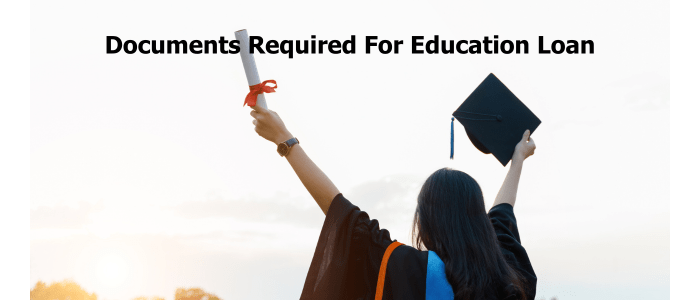
Summary: Dive into the documents required for your successful education loan process to study abroad. Learn in-depth about the documents required from the student, co-applicant, and those sent by the lender at different stages of your education abroad loan process.
Table of Contents
- Documents from the student and co-applicant
- Documents required for a US cosigner loan
- Documents to be sent by the lender
- Documents required after disbursement of the loan
Education loans help students to study abroad without worrying about the finances. Depending on the student’s needs, they can apply for any of the two types of loans in the market –
- Education loan with collateral
- Education loan without collateral.
A crucial stage of your loan application process is documentation. Submitting the right documents establishes credibility and builds the trustworthiness of the student-borrower. Read on, learn about the documents you need to apply for an education loan, and take care to arrange them beforehand to avoid the last-minute hassle.
Documents from the student and co-applicant
The first set of documents to be submitted includes those which proves the identity and financial credibility of the student and the co-applicant, which are listed below.
- KYC documents: KYC or Know your Customer documents are identity proofs issued by an authorized body. In India, the government issues KYC documents for all the citizens. When you go for an education loan, it is mandatory to provide valid KYC documents of you and your co-applicant.
Examples of KYC documents: Aadhar card, PAN card, Driving license, Passport, Voter’s ID
- Address proof: Typically, the KYC documents can act as address proof if the current address is the same as the address given in the KYC documents. If there is a change in address, you may be asked to provide current address proof, such as electricity bill, rent agreement, etc.
- Passport-size photographs: Recently taken passport-size photographs of the student and co-applicant must be submitted.
- Academic documents: For education loans, the student must provide academic documents as proof for eligibility. The academic documents to be submitted includes the following:
- Undergraduate degree certificate (for PG courses, minimum 60% pass)
- 12th result – minimum 60% pass for all streams
- SSLC certificate – minimum 50% pass
- Entrance test results with the minimum prescribed win – GRE, GMAT, IELTS, TOEFL, PTE, SAT, Duolingo, etc.
- Proof of admission to a recognized university. If yet to get admission, it can be negotiated with the lender
- Schedule of expenses issued by a valid authority or self-attested with proof
- Course prospects, if available
- Gap certificate if there has been an academic gap
- Financial documents: The student and co-applicant should not have existing loan dues, and they must provide proof of their financial credibility for an education loan. Normally, the student is someone fresh to financial activities. In those cases, the financial documents from the co-applicant are scrutinized to ensure credibility.
The table below presents financial documents required from co-applicants.
| From salaried co-applicant | From self-employed co-applicant |
| Form 16 copy for last 2 – 3 years Copy of IT returns Last 3 salary slips Last 6 months bank account statement of the salary account Statement of assets and liabilities | Business address proof Form 16 A/ TDS Certificate Last 6 months bank account statement Statement of assets and liabilities IT returns, for IT employers |
- Collateral documents: For education loans against collateral security, the student must assemble all the documents connected to the collateral.
- For plot or building: Title deed & Sales deed, registration receipt, Chain deed for the last 30 years, copy of tax paid, and other certificates from the government.
- For fixed deposits: An FD certificate issued by the bank
- For insurance policies: The policy paper and Surrender Value certificate
- For government bond: A valid Bond certificate
- Experience certificate for working professionals: If you are a working professional, submitting your experience letter will be an added advantage in your application. You may look for experience-based products, such as those offered by ICICI bank, Axis Bank, Indian Bank, etc., subject to their terms and conditions.
Documents required for a US Cosigner loan
The US cosigner loan denotes an education loan taken from a US bank with a US citizen as your cosigner for the loan. The following documents are typically required for a US cosigner loan:
- Offer letter or proof of admission to a US university
- Cost of study as documented in I-20 form
- A loan application form
- Original or transcribed education certificates
- Proof of qualified exams like IELTS, TOEFL, GMAT, GRE, SAT, etc.
- Residential proof of student and co-borrower
- Co-borrower’s IT returns
- Identification and banking proofs of the co-borrower
- Co-borrower’s income proof
- Student’s passport copy
- Details of assets/liabilities of the co-borrower
Documents to be sent by the lender
Once you submit the above-listed documents, the lender will assess them for a final decision. If your application is successful, typically, you will receive an official letter either via email or post confirming your eligibility for the loan and the loan product’s details. This letter is called an education loan sanction letter.
After receiving your sanction letter, you acknowledge the terms and conditions and revert back to the lender. Disbursement of the education loan takes place on dates specified in the sanction letter.
Documents required for disbursement include
- Disbursement request letter duly signed by the student
- University fee demand letter
- Student’s academic progress report (previous semester’s)
- Copy of the payment receipt of the previous disbursement
Make sure you follow the stages of your education loan application properly. Remember, if you fail to submit the required documents in the right format, there can be an instant rejection, and you have to begin the lengthy process once again.
Read Also:
- Education Loan Eligibility Options
- US Education Loan: Know all Details
- Education Loan for Abroad Studies
- Difference between NBFC and Banks
Documents required after disbursement of the loan
An education loan process ends after years, only when you complete the repayment. The following documents are crucial after the disbursement stage:
- Proof to claim government interest subsidy: To select students, the government offers interest subsidy through different schemes. Enquire in detail about the subsidy schemes available for you and gather the proof accordingly.
- Eligibility document for a tax deduction for the interest you pay: According to Section 80 E of the Income Tax law, a student is eligible for tax deduction for the interest on education loans for a period of 8 years from the date of repayment. You must obtain a proof from the lender to avail the interest subsidy while remitting the tax. Note that this subsidy is available for education loans from banks and HDFC Credila, not from other NBFCs.
- Document to claim tuition fee tax rebate: Under Section 80 C of the Income Tax law, students are eligible to claim a reduction from the tax to be paid for the tuition fee. Make sure you obtain the proof to substantiate your claim.
In a nutshell, there are three sets of documents for your concern – those from the student, the co-applicant, and from the lender. Be well-versed with the stages of your application and time when you have to submit the documents. Critically examine them before submission to avoid a last-minute rejection, since a minute error in the documents may affect your application.
Most often, you apply for an education loan after getting an admit to a recognized university abroad. The challenge before you will be getting the loan process done within the limited time. We understand that, and at Nomad Credit, we help you understand the many education loan options available on the marketplace and how they may fit your profile. Take advantage of the opportunity – fill the form and enjoy a hassle-free education loan option search process.
Frequently asked questions
Is the list of documents the same for all education loan lenders?
The basic set of documents required for an education loan is the same for all public and private banks and NBFCs. For some international lenders, there is no need to submit the co-applicant documents since they provide education loans without collateral or co-applicant. For banks in the US or any other country, the requirement of documents adhere to the criteria followed in that country.
How much time is required to process and evaluate the education loan documents?
The processing time for your documents varies depending on the lender’s convenience. Typically it ranges from 2 to 15 days or a maximum to a month.
How can I submit my education loan documents?
The documents can be submitted online or offline, depending on the lender’s instructions.
What to do if I miss any document required to apply for an education loan?
In case you don’t have a particular document or you need more time to submit it, contact your lender and inform them of your concerns. The lender will make the necessary arrangements and help you get the loan on time.
Is it mandatory to submit the documents at an early stage of the education loan application?
Your documentation process begins right after you fill out the loan application form. If you are late to provide valid documents, your application will take more time to be processed.

